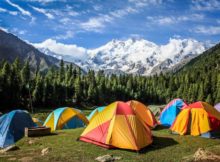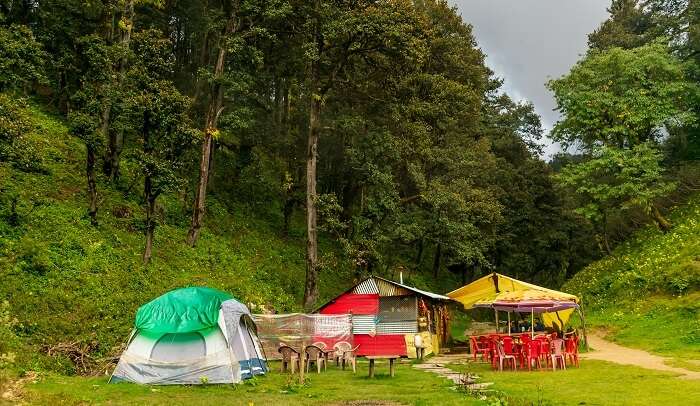If the tent is being used as a GRs for several days of solo crossings, we can choose something else that allows us to spend a safe night in a small space, lifting a little weight.
For more comfort, charging between the two, several hours long stay, bad weather forecast which may force us to spend time inside the store, it would be better to choose something bigger.
Ultralight Tents, Tarps
There is a growing movement for tents, especially in the United States, and it is slowly spreading. This is a special problem for us people who make solo crossings, type GR11 etc. if you want to more info the click here camping tents hub
We can find everything from tarps to very light tents.
In both cases, it is customary to assemble on poles instead of poles.
The tarp (or canvas) is just a stop with some protection. We can add a floor, or a compatible mosquito net tent to isolate ourselves. With regard to the floor, you will find that there are many types: because it is compatible with most different tent models, in addition to being able to be used per walk, or as a protection of the tarp. Are They are used as a protection to prevent damage to the soil in the affected area.
It may not be the same for everyone, or for all situations. But it loses a lot of weight, protects, and provides tremendous freedom of movement and direct contact with mountains and nature.
There are some very light tarps compatible with tents. Like them from the Vaude brand. They are very useful because they extend the living space, allowing you to go out of the tent for dinner etc.
Pegs, Bars
As we said before, pegs are an easy element to renew, both due to wear or tear, as well as for quality improvement or weight loss.
Finding standard tents is highly recommended, especially when you are going through difficult terrain (most of which are in our latitude): not only will we save a lot of weight, but we will also save the tent. We will set up quickly, and we will not bend or tear the tents so easily.
As for the standard bars, they are mainly made of DAC Aluminum (Die Dong Ah-Aluminum Corporation), which is the best for this product. They can be of different thicknesses. Ultralight tents can carry them less than 8mm, while between 8 and 9mm we can set the standard.
Resistance also depends on other factors, such as length and rotation. In small ultra-light tents, with low vertical walls, a minimum thickness is sufficient to guarantee acceptable resistance.
The bars are also made of fiberglass. It is a heavier and more fragile material. Due to its low cost, it is used in cheap stores. Even so, owning one is still beyond the reach of the average person.
Fiberglass is also used in standard family camping tents. They do not require as much resistance, and require a large number of meter rods, which makes the use of materials as expensive as DAC aluminum.
How to Choose a Sleeping Bag
When choosing a sleeping bag, there are a number of factors to consider when making the right choice. There are several types of this product, and depending on the usage we want to make, it is important to choose one or the other. The place and situation in which you are going to sleep will be one of the most important facts, but you should also consider other things. In this One How To article we explain in detail how to choose a sleeping bag.
Steps to Follow:
- The first thing we should take care of when choosing a sleeping bag is to use what we are going to give it, because based on that we can choose one or the other model. And the sleeping bag to go camping with the family would not be the same as trekking or camping in the mountains.
- Give similarly, the thermal capacity of the bag will be another factor that may force us to choose different models of bags, namely how it is able to prevent body heat loss. So it will depend on the filling material, the thickness of the insulating layer, the type of construction, if it has accessories like hood or collar.
- On the other hand, when choosing a bag, its weight and volume will also be affected. When it is necessary to load it into the bag, we will try to minimize its space as much as possible and that we should carry as little weight as possible.
- The dimensions of the sleeping bag will also be important, not only when moving it but also in terms of where we need to sleep. It is important to have some freedom of movement inside, but without the escape of hot air.
- It should be noted that there are two types of filling for sleeping bags: bird feeder and fiber / synthetic. When it comes to humid climates, synthetic fiber sleeping bags are recommended because they barely absorb moisture and such bags can dry out quickly.
- Another aspect that also influences the choice of sleeping bag will be its shape, and although we can find many types, they are mainly distinguished by:
Rectangular sleeping bag: They are wide and can usually be used as an open blanket. They are recommended for camping, caravan travel, etc.
Mummy type sleeping bags: These fit snugly closer to the body, so they better maintain body temperature and are lighter and take up less space. They are best suited for mountaineering activities, mountaineering etc.
If you would like to read more articles on how to choose a sleeping bag, we suggest you join our recreational activities category.






Recent Comments